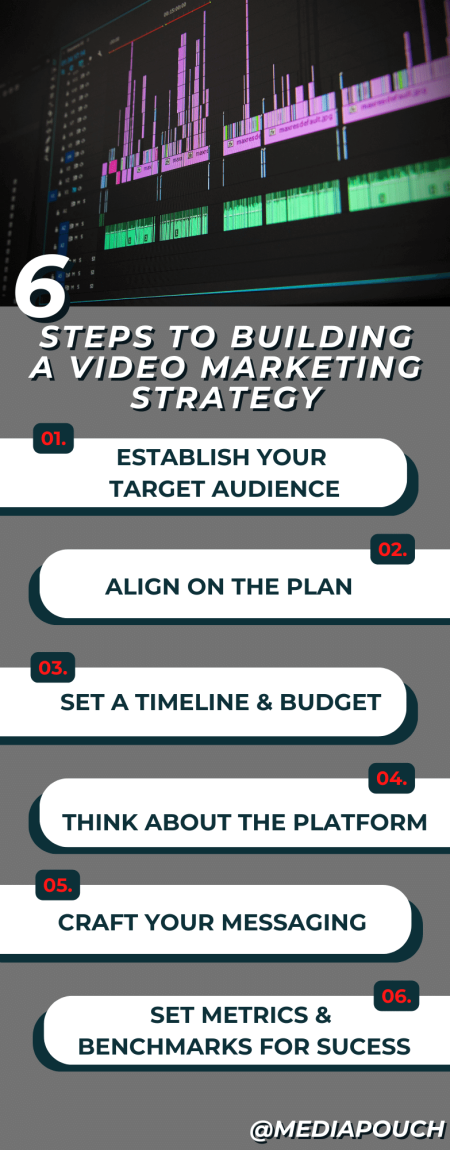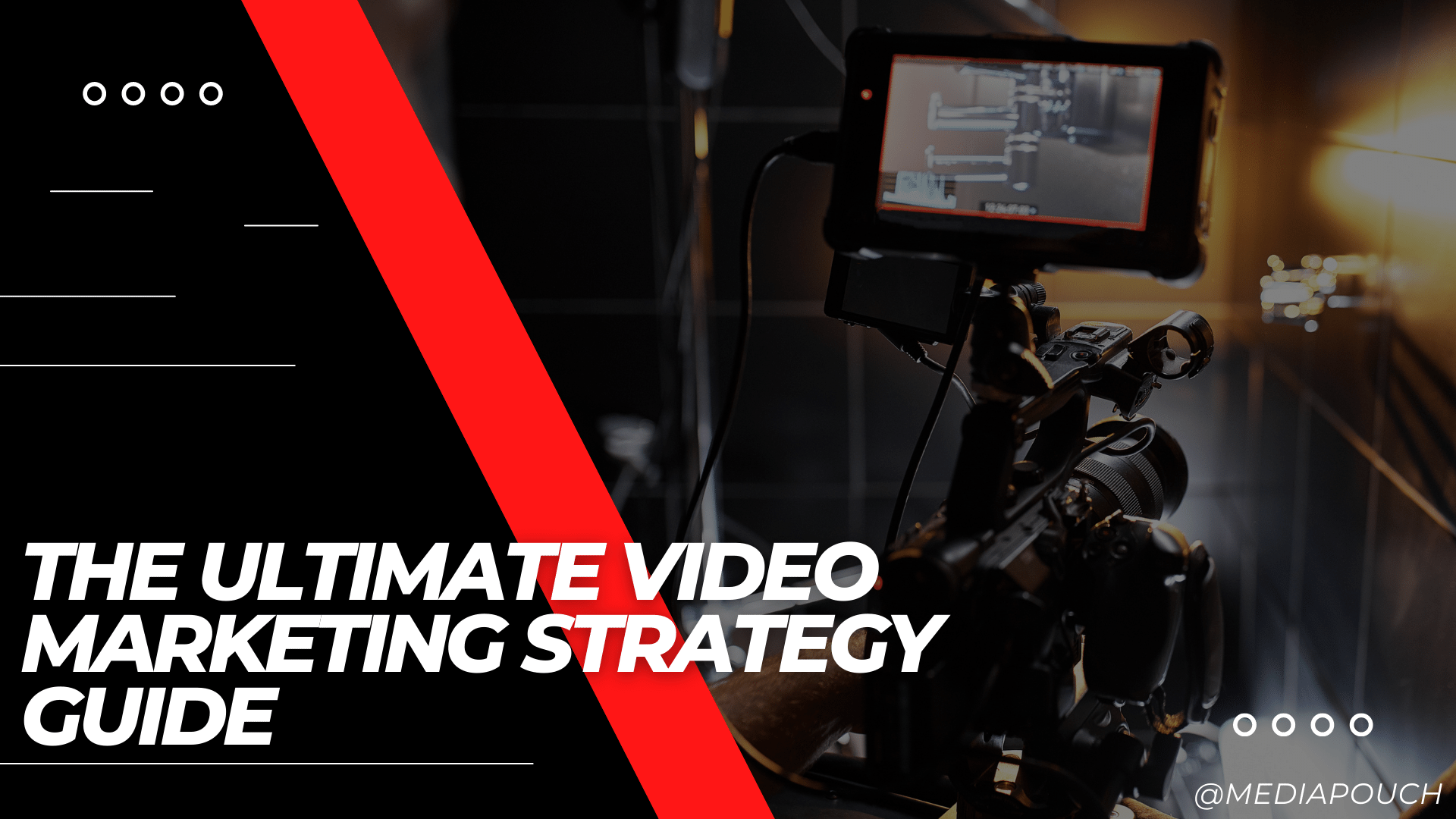Here's What We'll Cover
Are you thinking of creating a video marketing strategy for your business? If so, you’re not alone. In fact, 79% of marketers not currently using video plan to work on a strategy in 2022, and just about all of those already using video say they’d like to use it more. It’s hard to deny the importance of video marketing.
Where brands could once get by on written content and images alone, consumers are now looking for live streaming, interactive 360 videos, augmented reality, and more. Relying on text and still images can make your brand seem uninteresting and unengaging. So, how do you get your business in on the $135 billion-dollar digital video marketing industry?
Once you’ve realized the value of video production and the investment in distribution, the first step in leveraging the power of video is by creating a video marketing strategy. You’ll see the best results from video when you take a laser-focused approach to how and why you use it. In our ultimate video marketing strategy guide, we’ll share a step-by-step process for creating, distributing, and optimizing video content to engage your audience and transform your ROI.
The Goal of Your Video Marketing Strategy
Before you even reach out to a video production company, you should have an idea of what you’d like to accomplish with your video marketing strategy. With a clearly defined purpose, your strategy will be more refined and drive better results. The goals of video content should be linked to one of the four stages of the sales funnel process.
Awareness
A video for awareness is created with the intent to help the viewer realize they have a problem and that your brand may have a solution to their pain point. This stage of the video marketing sales funnel is attracting users and introducing your brand to a new audience.
Consideration
Now that the prospective customer understands they have a problem to solve, they’ll be looking for more information on a possible solution. The customer will look for recommendations or reviews. Video content linked to this phase should be informative about your solutions and build trust that you’re the right business to choose.
Decision
At this stage, the customer has determined the solution that is right for them and must now make a final decision on a provider. Your video content in this phase should be geared towards remaining top-of-mind. Provide your audience with more content proving customer satisfaction and why your services beat the competition.
Retention
The work doesn’t end when you close a sale. Your video marketing strategy should include content aimed at retaining customers by demonstrating your value and increasing brand trust.
Steps to Building a Video Marketing Strategy

Once you have determined what you’d like to achieve with your video content, you can start to build a step-by-step video marketing strategy.
Establish Your Target Audience
When you’ve figured out the goal of your video, talk with your video production about your target audience. Fully understanding your target audience puts you in the best position to focus your efforts directly at the population you want to engage. It is very important that you choose a target audience that can support your progress toward achieving your goal. Otherwise, you’ll be wasting time and money on a video marketing strategy that can’t get you anywhere.
The target audience may vary depending on the product and message you’re driving and the problems you’re looking to solve. You likely tackled this part of the project during product or service development, but it is essential to make sure this information is fully conveyed if you want your videos to be successful.
Align On the Plan
In most cases, your video marketing strategy will involve input from several stakeholders, so it is important that everyone be aligned on the plan to keep the project on track. It may be worth your time to survey your stakeholders on their goals and expectations of the strategy so you can collate the response and create one clear path forward.
Set a Timeline and Budget
Video production can be simple or labor-intensive depending on the final output you have in mind. Before you bring your ideas to a video produ
ction company, you need to have a set timeline and budget for your project. This will help manage your expectations around what you can afford and how fast the project can be turned around. Even smaller video production projects have a lot of moving parts and require the skills of many people, so you should anticipate a few unexpected changes or delays.
Think About the Platform
Before you produce a video, you should already know where you intend to distribute it. Videos of different lengths and styles may perform better on one type of platform versus another, and the overall goal of the video might determine which of these platforms will get you the best results. YouTube SEO is quickly becoming just as important as website SEO, so keep that in mind as you plan your distribution channels and, ultimately, your overall video marketing strategy.
Craft Your Messaging
Your videos won’t get you closer to your goals if the messaging doesn’t reach your audience. When you work with a video production company, you’ll want to ensure that the video tells your brand story and conveys all the information about your product in a clear and distinct way.
You want your message to be relatable and attention-grabbing while demonstrating your product’s value. And don’t forget a call to action. Consider the budget, skills, and resources available to you and figure out how to leverage those pieces into the most cohesively messaged video.
Set Metrics & Benchmark for Success
Since you should set your goals before starting video production, you’ll already have that covered. But your video marketing strategy should lay forth what metrics you’ll be using and what success will look like. If your goal is to raise awareness, perhaps the view count on your video would be your metric. Other videos might be better judged on their engagement like comments and shares. If you’re not sure where to start with metrics, check out this list of options.
Using the Right Video
In the next section of our video marketing strategy guide, we’ll tell you how to choose the right videos to achieve your goals. There are seven types of foundational ad videos to choose from. Let’s take a look.
Spokesperson Anchor
This type of video features a spokesperson talking directly to the camera, explaining the product and highlighting its features. These videos are highly engaging because the spokesperson is a relatable figure speaking in a conversational style. Because they usually involve sets and props, spokesperson anchor videos can be higher in production value.
Social Proof
These videos feature a real customer talking about their experience with a product or service. If the budget is big enough and the purpose dictates it, celebrities or influencers could be used for a social proof video. The videos should incorporate a real-time demonstration and authentic commentary. Social proof videos should look organic with little production value.
Product Demo
Use product demos in your video marketing strategy to show off your product and how it works. Whereas social proof videos are meant to be more organic and authentic, you have a little more production wiggle room with product demos. You can make the product look beautiful and brag about all its features. Make sure the product is explained in an easy-to-understand way.
Case Study
Case study videos are an opportunity to educate your product on a deeper level. You can present tangible data or compare your product to other brands. This type of video production is a great way to showcase your results.
Lifestyle
Lifestyle ads are a type of video with an almost cinematic video production value. There are usually multiple scenes and images used to evoke the emotion you’d feel when using a product or service. Rather than directly selling the product, lifestyle ads sell aspiration.
Unboxing
The experience of buying and getting a product can be just as important as the product itself. Unboxing videos demonstrate this. These videos are a hybrid of product demo and social proof, where a customer who has purchased a product will open it and set it up on camera and talk about their initial impressions. This type of ad is easy to use and looks very organic.
Dynamic Ads
Dynamic ads are relatively boring because they are produced in bulk, often by big box stores that will use them as templates for several products. They aren’t really aimed at selling you a specific product but, rather, a type of product like a laptop or a TV.
How to Make the Perfect Videos for Your Ad
Feeling stuck in your decision on what video to make for your ad? Want to make sure your hard work pays off? Here is a 3 step process to use a guide in your search for video marketing gold.
Define What You Want to Say
Video ads are the new frontier for marketers looking to grow their brands. They’re all about creating a path for your target audience to discover your company. Once they hear about you and your services they will want more information on what makes your company different from everyone else in the market. You achieve this mission by defining the messaging you want your video ads to convey so that your target audience has everything they need to make an informed buying decision.
Add Purposeful and Creative Content
When you know what message you want to convey, the next step is to think about the different ad types that will communicate your messaging most effectively. Some examples are: Side by side comparisons, unboxings, and product demonstrations. Each approach has its own unique purpose in mind for reaching your potential customers but you can always improve its effectiveness with some creativity and the right pairing of content.
Listen to Your Audience
Finally, an obvious but often overlooked place to look for ad ideas is the comments section of your previous videos or FAQ page. Learn what your prospective customers are most curious about regarding your product. Double down on this interest to grab their attention and increase engagement.
If you’re getting good engagement from one specific topic in your content, then try duplicating it by making similar content. Your viewers will give you the feedback you need through online conversations so take note when someone asks something specific because that might be your next paid invoice from a new customer.
Why Hype Videos Work
Hype videos are an opportunity to put unique and creative content in front of your audience. This is where you can really let your video production company take the reins and deliver exceptional content to captivate your ideal audience. These videos are focused on showcasing your business and products and all the things that set you apart from your competition. They grab attention and evoke emotion to get the audience curious about your video.
Why PPC Videos Work
Pay-per-click (PPC) videos are useful because the content is engaging and drives viewers to connect with your brand, which is an important first step in creating great relationships. These videos are an efficient sales tool because they put your products and company info in front of far more potential customers than an inbound sales team.
Why Social Media Videos Work
When you have high quality video production for your social media content, you’re boosting your credibility with your audience, and they’ll soon begin to associate your brand with success. If you use customer testimonials on your website, you can generate about 62% more revenue from every customer, every time they visit your site.
Distributing Your Videos
After you finish your video production, the next part of your video marketing strategy will be determining the best way to distribute your videos. Here are some tips for making the most of your distribution.
Don’t Release All At Once
The most efficient way to tackle video production is to get several videos done at once, but it isn’t a good idea to release them all at the same time. You should plan on releasing one or two pieces of video content per week.
Thumbnails & Titles
When you distribute your videos, be sure to title the video appropriately with something descriptive and catchy. On most channels, you will also need a thumbnail image for your video, which is a small image that sits by the description of your video. Some platforms will automatically assign a thumbnail view to your video. We recommend creating a custom thumbnail with its own title that’s unique from the video title. This gives your viewers another chance to stop the scroll.
Add Metadata
Metadata is information that describes your video and makes it readable to search engines. Adding metadata makes it easier for your audience to find your videos on sites like Google. If you add metadata to your video, you also have an opportunity to incorporate SEO, which can be a big advantage to your SEO campaign performance.
This is what turns a regular video into a video asset. If there’s no metadata in your video and you only upload it to Youtube and input keywords there then only youtube will be able to read your videos for a while. Google will eventually be able to but it takes time. This is also why it’s important to export your video with open captions as they give Youtube and Google another opportunity to read additional data that describes what your video is about.
Optimize for All Platforms
Different social media sites, YouTube, Vimeo, and other platforms each have a specific set of dimensions for photo and video content that looks best. Your video production company should be familiar with these specifications. As you are working through video production, make sure to get files in the right proportions.
1:1
Video ads created with a 1:1 aspect ratio should have a minimum resolution of 600 x 600px, and a maximum resolution of 1080 x 1080px. Videos with 1:1 aspect ratio are commonly seen on mobile platforms like Instagram.
4:5
4:5 aspect ratio videos appear nearly vertical with a frame that is 1080×1350 pixels. You can also use this aspect ratio on Instagram and Snapchat ads.
9:16
9:16 is a vertical frame of 1080×1920 pixels. This is used for Youtube shorts, TikTok, Instagram reels, and Snapchat.
16:9
Videos in 9:16 aspect ratios will appear in a portrait orientation on a screen, meaning they are longer than they are wide. Videos on Facebook generally appear in this aspect ratio.
Measuring Your Success
A good return on investment might look different from business to business, but measuring your success is an important part of a video marketing strategy. In the next section of our video marketing strategy guide, we’ll go over some common metrics you can use to tell if your video content is hitting the mark.
View Count
The view count is the total number of people who have viewed your video. Each platform will measure view count a little differently. On TikTok, a video counts as viewed the moment it begins to play in the viewer’s feed. For Twitter and LinkedIn, a video must play for two seconds with 50% of the video on the user’s screen. Facebook and Instagram count a video as viewed after three seconds, and a YouTube video is counted as viewed after 30 seconds.
While it is nice to know how many views your video gets, it doesn’t really matter much unless those viewers are taking any more action. It is good to know, however, that the first seconds of the video are catching the viewer’s attention.
Engagement
Measuring your engagement takes a look at the number of people who are interacting with your video in the form of comments on the video platform. Videos with higher engagement rates are probably resonating well with the intended audience. However, pay attention to the types of comments you’re getting.
If you’re video is way off the mark, you may get some comments with negative feedback. Any feedback you receive via comments can be taken into consideration to help you improve your next campaign or develop a better understanding of what your audience is looking for.
Play Rate
If embedding videos is part of your video marketing strategy, play rate is an important metric. This number tells you how many people actually clicked “play” to view your videos as opposed to seeing it in an auto play situation. It is a valuable KPI because you know these viewers are taking an action on your content.
Play rate is calculated by taking the number of clicks and dividing by the number of people who accessed the video landing page. A few ways to boost your play rate include using an attention-grabbing thumbnail; including a human face in your thumbnail; and testing the location of the video on the landing page.
Watch Time
Watch time tells you the total amount of time that people have watched your videos. It is a cumulative figure that also includes replays and is calculated by dividing the total watch time by the total number of video plays.
This figure helps you understand how well your audience relates to your video. The longer the watch time, the more people are enjoying your video. Watch time is one of the most important video metrics because it can help you identify where your viewers stop watching the video and can clue you in on content that doesn’t work. You can swap out clips with another that will increase watch time and get the viewers to the end of the video and a call to action.
One of the most tried-and-true ways of beefing up your watch time is by starting your video with a teaser. Teasers are easy to implement by adding a creative element at the beginning of your ad to draw the viewer in. Some common types of teaser are ASMR, which involves using “satisfying” sounds, or showing something taboo or against the norm.
Social Shares
Social shares should be a main goal for any video marketing strategy. Each share widens your audience exponentially, which increases brand awareness and brings you new leads. Your social shares will be higher on videos at the top of your marketing funnel than they will on videos at the bottom.
Shares are generally higher with video content that is cheeky and entertaining or educational. Don’t be afraid to pile on the humor. Audiences love to view and share ads that they find funny, making humor the single biggest driver of share-ability.
Clicks & Click-Through Rates
If your video production is for an ad campaign with a call to action, it is crucial to measure clicks and click-through rate. Clicking and taking action on the ad is the goal of the campaign – you want viewers to end up on your website or campaign landing page to learn more about your products or services.
It is also a good idea to test a few different CTAs to see which works best and to ensure your content is engaging enough to draw viewers further along the customer journey. Click-through rate is measured by dividing the number of clicks your ad receives by the number of times the ad is viewed.
Having a good watch rate can improve your click-through rate, and having high numbers on both metrics can boost your content in YouTube algorithms. To keep your click-through rate up, it is important to place your link in the first line of the video description so it is easier for viewers to see without having to expand the description.
Conversions
If you can track conversions for your video content, you should. This metric will help you calculate your overall cost per lead, return on advertising spend, and overall return on investment. Conversions measure how well your video persuaded viewers to convert to a solid lead or make a purchase.
Tracking conversions is easier when you are running a video campaign, but it can be done for educational or organic video content if you are able to get tracking and UTM, or Urchin Tracking Module, tags on the content. The UTM parameters in a URL identify the campaign that refers traffic to a specific website.
It is usually recommended to create separate landing pages for the purchase of the product or service linked to the video campaign in order to better track conversions. In addition to your video marketing strategy, every other marketing strategy you employ should measure conversions to adequately assess how well time and resources are being spent on a campaign.
Using Video to Boost SEO
Our video marketing strategy guide wouldn’t be complete without mentioning how using video production can boost your SEO results. When you add more video to your website, you are helping your business outrank competitors on Google and other search engine sites, and there is proof to back that up.
In a survey of marketers using video, 86% say video has increased traffic to their website, and 78% say it has improved sales figures. Video SEO is powerful, and you should consider putting it into your marketing strategy. If you need some tips on how to leverage your video to improve SEO, check out our Ultimate Video SEO Guide.
Video Marketing and ROI
It is true that working with a video production company may require a bit of an investment, but you might be surprised about the return video marketing can get you. Depending on your industry, it might only take one or two good leads to achieve positive ROI. Sometimes though, you can see ROI over the long term, and that is where it counts the most.
One benefit of video production is that the content lives on forever. Any video footage you collect and produce can be used over and over again for different campaigns. This means you can save time on future productions because you will need less original footage. A great video production company partner will store your footage for you so it can be accessed in the future without any additional charges.
Media Pouch: Video Production to Get You Noticed
You’ve got an epic brand and dreams for where you’d like to see it go, and a video marketing strategy might just be what gets you there. Media Pouch wants to be along for the ride. We’ll help you create top-of-the-line video content to get you noticed and boost your revenues. Contact us today to get started.





